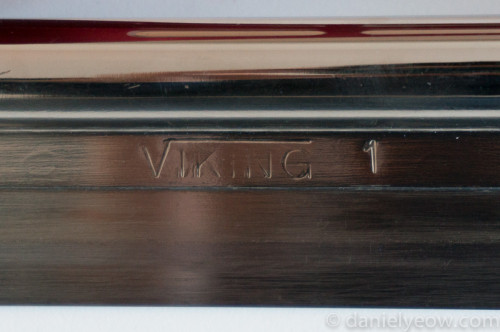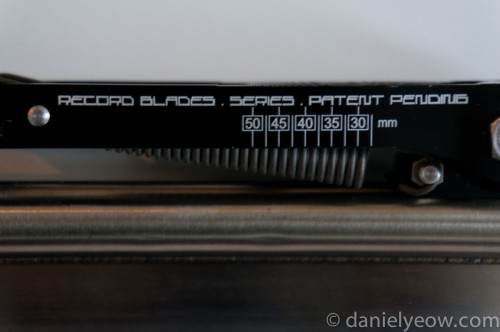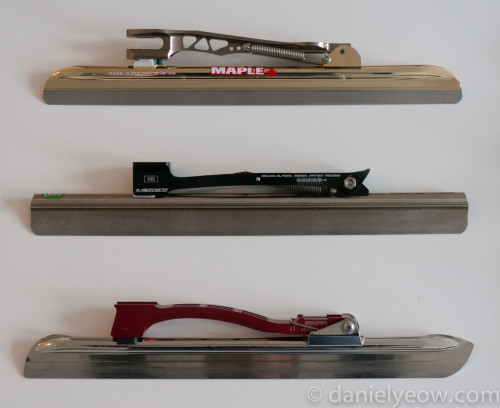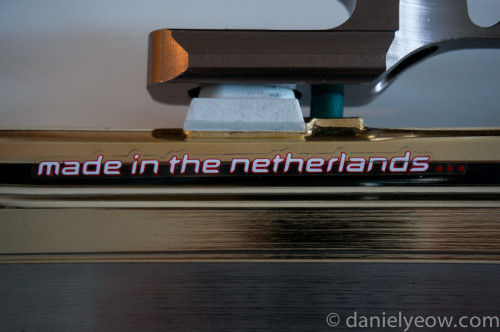Blades of Glory
There are really only three blades you need to consider if you are a serious speed skater. This is not as bad a state of affairs as you might think – a few years ago there were only two. Speed skating blades are fascinating things because the task they need to accomplish seems so simple, yet amazingly we have three VERY different tools built for that task and we realise that the dream of making the “perfect blade” may be more difficult than it may at first appear.
It is worthwhile to note that all three of these blades are manufactured in the Netherlands. The brands may be named “Viking”, “Maple”, and “Marchese” respectively, but they are dutch through and through. (I’ve always secretly wanted to start a blade company called “Tulip” where everything is made somewhere in Asia). For those readers unfamiliar with the ice skating world, there are many brands who manufacture ice skate blades (all based in the Netherlands) but none of those other brands make particularly good blades.
I have been fortunate enough to have had the opportunity to try out each of these blades. In fact, as of writing this, I own a set each of all three. “Trying them out” doesn’t just mean putting them on for a few sessions, for me it means to skate on them for several months to get used to the uniquely-different “feel” that each blade offers, and then on at least a few occasions to race on them. The racing is the most important part of the test, since it is the point at which skater and equipment are being pushed to the limit. You never really know how steady you are in the corners on a set of blades, until you have to hit a second-inner corner in a 500m in them, and you don’t quite know how easy it is to steer a set of blades until you’ve had the opportunity to try it in the dying laps of a 3K or 5K.
The Vikings

Interestingly, the manufacturing process for Viking blades hasn’t changed for a VERY long time. Even old fixed-blade long track skates from before 1996 were manufactured in the same way.
These are the blades on which I learned to skate. These are the blades on which everyone should learn to skate. They are the softest out of the three. There are three basic variations of this blade to consider – regular, PM steel, and PM with nickel tube. I always recommend the softest blades for people who are learning to skate because they give the most obvious feedback on the way you skate. I talk a lot to the skaters I coach about “ice feel”, and a softer blade will generally give you better ice feel. However, in a strict technical sense, it isn’t the ice that you’re necessarily feeling – it is the interaction between your body’s stabilisation muscles and the feedback they’re getting from what the blades are doing. The metal in the “runner” bends and flexes as you put pressure on the blade while you skate, and the way that you do this affects the shape of the running surface – that is – the point of contact between the blade and the ice, which is typically a curved line. I guess what I’m trying to say is that a softer blade allows the skater to more easily feel what that line is doing.
PM steel is simply a reference to how the blade is manufactured. PM is short for “powdered metal” in case anyone is wondering. It simply means that the blade is harder. I’m pretty sure there are actual numbers to back this up, as in Rockwell hardness and the PM steel is a three or four notches up the scale. In practical terms, this translates to more glide in the same way that a bike with higher pressure in the tires will roll better than a bike with almost-flat tires. Other practical matters to consider are that PM steel takes longer to sharpen, but will also keep its edge for longer. This is not so important for most long track races, but for a marathon skater, being able to keep sharp edges all the way to the end of a 100-lap race on not-very-nice ice is a huge advantage. The nickel-plated tube is claimed to be nothing more than a cosmetic improvement, but I am quite certain that it has a very small effect on the stiffness of the tube, and therefore also on the way that the blade flexes.
I like these blades, a lot. The ice feel in the straights is the best out of all three. Unfortunately it’s in the corners where they don’t quite do it for me. At top speed (admittedly, not so fast these days) I find that I have to carefully step through inner-corners, and I’m only forcing myself to do that because I know that it is quicker than sliding through the corner on both feet. Of course, I would much rather put power down in the corner and it is for this reason that I eventually went off them. Perhaps it is because I took up the sport so late in life that the stabiliser muscles in my lower leg can’t handle it, but the fact of the matter is that when I’m right on the limit, I can’t control these blades as well as I would like to be able. So… as awesome as they feel during practice, they are not my blade of choice for racing.
The Marcheses

these measurement lines are useful for remembering your own setup, but cannot be transferred between different blade manufacturers
Marchese is a relative newcomer to the scene, at least when it comes to ice blades. The name should already be familiar to many speed skaters since Paul Marchese has been producing some of the world’s most sought after custom boots for quite some time. The blades, being mass-produced, would not be expected to attract the kind of 9-month wait for a new set that the hand-made boots do. But are they any good?
The design of the Marchese Record is the first major rethink of the design of ice blades in quite some time. The “traditional” way to construct a blade is to begin with an incomplete tube (i.e. a rectangle) and bend it into a cylinder, then weld it onto the runner (the bit that touches the ice) rather like closing the incomplete circle onto the straight line on an electrical appliance’s on/off switch. Originally (before the advent of clap skates), the steel of the runner simply continued on to wherever the blade mounted onto the boot, but for obvious reasons, this caused the blade to flex less at points close to those mounting points, and flex more everywhere else. The tube basically moderates this effect and causes the blade to flex more consistently. There is however the issue of the strength of the tube. These days they’re spot-welded (in the case of the Vikings) or laser-welded (in the case of the Marcheses and Maples). The Marcheses have taken a different approach to the tube-runner equation by starting with a complete tube, then welding the blade directly onto that – something made possible by advances in welding technology (I’m told).
This raises some interesting possibilities. First of all, the tube can be much stronger while staying the same weight, or be the same strength while being lighter. If the tube is stronger, then the distance from the tube to the ice can be greater. The whole point of the tube is to control the extent to which the runner flexes, and if the tube is stronger, then you can make the height of the runner greater while retaining similar flex properties of a lower runner – in theory. In practice, this seems to be mostly true, but with an interesting side-effect – since there is physically more blade, even though it seems to flex a similar amount and in a similar way to a conventional blade, the amplitude of this flex seems to be greater. Remember how I talked about that curvy contact line that the blade makes with the ice? This one is curvier.
In real skating terms, this makes for an interesting blade. They made the runner metal harder because they knew that having more metal would make it flex more. This enables the blade to glide very well on the ice, while also not being too stiff (and ice blade with no flex is useless for speed skating because steering the blade is essential for generating the force needed to go fast). Having a harder metal, as mentioned above, also allows the blade to hold its edge for longer – not really an issue in long track, but a potential consideration for marathon skaters. The extra flex properties manifest themselves most notably at the end of the push – the blades “turn in” a lot. When you’re used to skating on Vikings, it can be too much. But if you’re the kind of skater who gets to the end of the push without a huge angle (from perpendicular, measured at the knee or hip) then this turn in can give you just a little bit of extra pressure for free, or save you the trouble of pressing down that extra little bit to extract the last bit of pressure from a Viking blade.
Another thing – the “pitch” of the bridge is 10mm – same as the maple blade (the pitch of a Viking is 12mm, the bridge is the thing between the blade and the boot) but the relative difference between the distance from the toe-mounting to the ice and the heel-mounting to the ice is significantly less than the other blades – there’s more blade under the toe, so your feet feel “flatter” in your skates. This may suit some people, and not others, but it’s something that everyone should be aware of. Personally, I think the Marchese blade is the ultimate marathon blade, but will only suit a small percentage of long trackers (notable among them, Bob de Jong). Personally I found it difficult to get used to how the blades behaved in the corners, and was able to skate in the straights fine, but always felt that I wasn’t extracting all that I could. They glide well, and are ideal for situations where you have to hold a high, sub-top speed. I broke old personal bests in the 1000m and 1500m in these blades, but couldn’t manage it in the 500m. As of writing, there are two variants of this blade – the regular one, and the “sprint” one, where the runner is thinner (0.95mm rather than the standard 1.1mm) which is supposed to behave more nicely – more similarly to the other blades out there.
The Maples
Last but not least is the Maple gold. “Maple gold” actually covers four distinct but quite similar models of blade manufactured by Maple in the Netherlands – the Maple Comet Laser, the Comet Laser Flex, Twin Laser, and Twin Laser Flex. The difference between the Laser and the Twin Laser is the welding pattern between the tube and the runner. The difference between Flex models and non-Flex models is the tube is constructed differently so as to allow more flex (in the Flex models).
Early in my (very short) ice skating career, I switched from Vikings to Maples. This was at a time before the flex blade existed. The corners felt much more “solid” than with the Vikings. However in the straights the feedback from the blades wasn’t great and I couldn’t reliably steer the way that I wanted. To be fair, a lot of the reason for that was my own technique, but I probably missed out on a little bit of positive feedback when I did manage to “hit it” properly.
An opportunity came up for me to try out the Marchese blades, so I took them up, skated a few months on them, then raced Calgary Oval Finale. Even though I set two new PBs (including in the 1500m which was a surprise because, well… I don’t really train, and that distance requires good physical conditioning to do well) I wasn’t satisfied with the way that the blades behaved so I switched back to Vikings. I skated a whole season on them which included even more PBs and went into Oval Finale fairly optimistic. But then an opportunity to try out the Twin Laser Flex came up and I took it. Jet-lagged and jelly-legged from a crazy two months of near continuous travel I threw them on and skated expecting not-much and… they felt amazing. I had the same solid feel in the corners that I remember from my previous maples, but the straights were completely different – I could really feel them, and steer. Perhaps foolishly, I decided to stick with them only three days out from the only major competition I do in the skating season.
I broke personal records in all of the distances I skated, some by a substantial margin. Maybe I would have done the same on the Vikings. Maybe it wasn’t just the blade, but the new bridge (Maple also designed a new bridge that flexes more) as well. This is not a very scientific experiment. The only real way to do that is to do what they did when they introduced clap skates – take two randomized groups of junior skaters, put one of them on claps and the other on regular skates and monitor their progress over the course of several seasons. And who knows, this might be the only way to convince elite speed skaters to adopt a significant new technology – the sport is so technical, and the tiniest differences can completely change one’s skating experience, it’s not surprising that they are slow to adopt new technologies.
There is actually an additional variant of the series called the “3-point” where instead of two points of contact between the blade and the bridge, there are three. This causes the blade to flex less in the middle, which likely has the effect of giving the skater more “pressure” at the expense of steering ability and feel. That blade, and the Maple Comet Aluminium (the predecessor to the steel “Gold” blade) I would recommend only to people who have grown up ice skating and already have a very well-developed “ice feel” (and who also like really really stiff blades), otherwise their stiffness and steering responsiveness make it difficult to make the fine adjustments you need to make as an ice skater.
So the Maples are my blade of choice, but they are not for everyone. The Marchese blades could use a few generations of development or perhaps a few more variants, but as they are now they are still a very good blade. Highly recommended for marathon skaters, as well as skaters who don’t make a very sharp angle with the ice (like Bob de Jong, as opposed to someone like Mo Tae Bum). The Vikings I would recommend to those who really like a lot of feedback from a soft blade, and who have straight ankles (mine are very pronated, which is probably why the blades seemed to “get away from me” when I put a lot of pressure on them in the corners). Another significant consideration is the stiffness of your boot – if your boots are very stiff you may want to consider a softer blade whereas if your boot is already very soft, then a stiffer blade might be more appropriate. The objective is generally to get as much flex in the foot-to-ice interface as you can get away with while still being able to maintain stability and control over your blades. For younger skaters, I would recommend erring on the side of being too soft, whereas for a more mature skater I would just tell them to go with what they feel most comfortable with in a race.
Postscript
I am selling some old blades. I have a set each of:
Viking PM with the nickel-plated tube, size 41 bridge, 16.5 inch blade. Used for 1 full season, 400 euro
Maple Comet Laser (non-flex), size 41 bridge (old bridge), 16.5 inch blade. Used for 2 seasons, 300 euro
Marchese Record, size-165mm bridge, 17 inch blade. Used for a third of a season, 500 euro
prices are negotiable.



Only about halfway through did I realize I’m reading a review for something I will probably never purchase not own. Nevertheless, here I am at the articles conclusion.
As always, great writing – good enough to tug someone who lives in the desert all the way through a review of ice-skating equipment 🙂
you never know… camels in the street, nice steaks, a long track ice skating rink could be next…
Dear Daniel, nice review on those blades. Helps me a lot in my search for new ones myself. In order to compare your experience with my situation, could you tell what kind of skater you are? E.g. Heavy powerfull or light and technical?
Thanks, kees
Daniel, your contact me stuff is too complicated. I want to ask you a question about buying custom made blades – where I specify the length and shape of the blade. Does that even exist? Great write up btw, I’ll contact each of those companies.
hi David, and sorry for the slow reply. I’m not sure what you mean by ‘custom made blades’. It is relatively easy to specify the length of the blades when you order them (it’s a little bit like shoe size), and the ‘shape’ in terms of the radius and bend is something that a skater ordinarily gets adjusted themselves after or at the time of purchase.